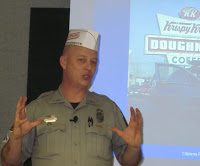Cop school: Life on patrol
 |
| Kottemann |
Greg Kottemann wanted to be police officer since he was a child, and his enthusiasm for the job was clear, as he offered a close-up look at the life of a patrol officer during last week’s session of the Citizens Police Academy at the Mount Vernon District Police Station.
Kottemann, a master police officer in Mount Vernon, demonstrated the tools of the trade, led a tour of the station, and in a move that guaranteed a positive review, passed around donuts from the Krispy Kreme up the road.
He passed around the belt all officers wear when they’re outside, and it must have weighed at least 10 pounds. It contained two extra magazines, handcuffs, walkie talkie, flashlight, mace canister, collapsible 22-inch “whacking stick,” and a replica of a .40-caliber automatic pistol. The guns officers carry are always loaded, he said, and the canister contains pepper spray that irritates the eyes and lungs.
Kottemann said his most important weapon, however, is “my words.” A big part of a cop’s job is negotiating. “Ninety-five percent of the time, we will talk you into coming to the station,” he said, and officers sometimes have to talk people out of committing suicide.
The vest all officers wear outdoors is bullet resistant, not bullet proof, he said. It is not going to stop a rifle.
The authentic Fairfax County police ID has a hologram, so don’t be fooled by an imposter. New badges will be issued soon with RFID (radio frequency identification) tags, which can store and transmit information and even open doors.
The rules for police pursuits have been tightened up in recent years. According to Kottemann, the decision whether to chase a suspect depends on the time of day, condition of roads, potential danger to bystanders, whether the officer knows the offender, the presence of other officers nearby, and whether the suspect flees to another jurisdiction.
There is a license plate reader mounted on the rear of police cars that automatically processes every passing car to identify suspects and stolen cars. Police officers drive modified Crown Victorias, the classic cop car, but Ford has stopped making them, so the department is evaluating other options.
 |
| Inside the patrol car |
The Mount Vernon station is the only one in the county with an actively used cell block. While we were there, we could hear three guys, who had been arrested for drunk and disorderly conduct, yelling and banging on the bars.
Suspects can be retained there for up to 12 hours, under the supervision of two sheriff’s deputies, before being transported to the Adult Detention Center in Fairfax. The station uses a patrol wagon (they’re not called paddy wagons any more). The brightly-lit interior is divided down the middle by a solid wall with a bench for men on one side and women on the other.
Patrol officers work the day (5:30 a.m.-5 p.m.), evening (1:30 p.m.-1 a.m.), or midnight (7:30 p.m.-7 a.m.) shift. Each shift has 13 to 15 officers and two supervisors. They alternate working five days one week and two days the next. Each police district is divided into several “police service areas,” Kottemann said, and officers usually stick with the same area “so they get to know the community and the bad guys.”
The bulk of the Mount Vernon stations’ 126 sworn officers are patrol officers. The others include nine detectives, five school resource officers, a crime prevention officer, a traffic enforcement officer, a parking enforcement officer, and two who just serve outstanding warrants. The detectives mainly focus on property crimes.
The station has a number of civilian positions, including police citizen aides, crossing guards, a crime analyst, and a volunteer chaplain. There are also “sworn auxiliary police officers.” They are unpaid volunteers who carry out certain police functions but are not allowed to carry firearms.
The proposed county budget would eliminate the police cadet program. The cadets, ages 18-21, learn about what it’s like to be a police officer before committing to that career path. One of the things they do is try to buy alcohol to see whether they get carded.
Everyone starts out as a patrol officer for the first two years, Kottemann said. He grew up in Mount Vernon and has been with the Fairfax County police force since 1989. He was a school resource officer at Mount Vernon High School and spent several years in crime prevention, where his duties included educating the community about safety issues and overseeing Neighborhood Watch programs.
Patrol officers are expected to be many things, he said: professional, respectful, unbiased, above reproach, fearless, level headed, and always in control, to cite a few. Being imperturbable is difficult, he acknowledged, because of “the meanness and depravity we see in people.” He monitors registered sex offenders and acknowledges, “It’s hard to be polite to some of these people.”
“We are often misunderstood,” said Randy Joyce, captain of the Mount Vernon station. “The Citizens Police Academy builds understanding. It gives you an opportunity to see the world through our eyes.”
In Fairfax County, there is one police officer per 900 residents. “That spreads us thinly,” Joyce said. “We can’t do our jobs without you.” He urges the public to “call us when you see something suspicious. You know your neighborhood better than us.”

